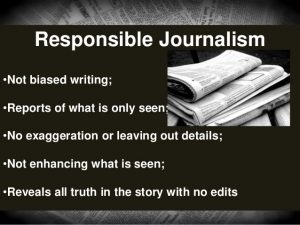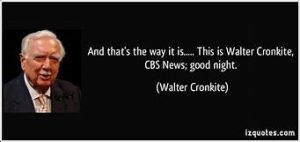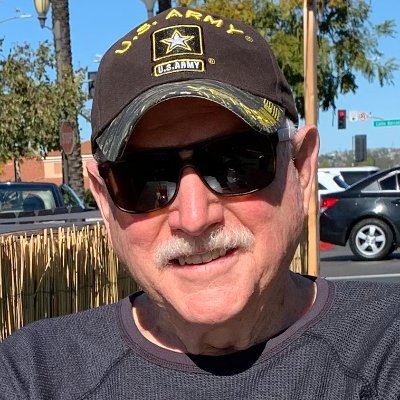The other day, I had a long conversation about the state of American journalism with a couple of friends. They told me, in no uncertain terms, that they don’t believe anything they hear, read, or see when it comes to the news today. “It’s all propaganda and what isn’t propaganda is usually biased and inaccurate,” one of my friends said. “What the hell happened, Ron? You were a journalist once. What’s going on?”
I have to admit; I am ashamed at the kind of journalism I see being committed today. My friend is right. News–especially news emanating from cable TV (and I use the word “news” advisedly)–is slathered in a thick coat of disinformation, indoctrination, and misinformation, otherwise known as propaganda.
The kind of reporting, if you want to call it that, that I see, hear, and read today is all too often filled with the reporter’s biases and political opinion. I would have been run out of the Chicago Tribune newsroom, where I started my career in the early 1970s if I had written the kind of partisan and dishonest stories I see today.
Eventually, our conversation turned to other topics, such as the Coronavirus. Once again, my friends argued that the media are fanning the flames of panic by reporting stories that are filled with inaccuracies.
Finally, I suggested that my friends read a commentary on the state of America’s news media that I wrote on my blog a while back. Here it is again for those of you who might have missed it. I hope it provides a few answers to some of the questions you may have about the news media. Read on.
Good journalism, somebody once said, is a nation talking to itself.
That’s “talking to itself,” not yelling, screaming, shrieking, talking over one another, and engaging in verbal bullying.
That is just about all we see on prime-time television–especially cable television–these days.
Primetime cable TV outlets such as Fox, CNN, MSNBC, CNBC, etc. continue to produce a proliferation of hosts and pundits with no foundation in journalistic ethics and tradition. Today’s so-called “news shows” more often than not degenerate into shoutfests where guests and hosts engage, not in any intelligent discussion of issues, but in contests to see who can talk the loudest or bully those who disagree with them into submission.
That kind of “squawk talk” comes with a steep price. What does the viewing public learn from such exhibitions of bad behavior?
The answer, I would argue, is not much. Because when people are yelling at one another, calling one another names or behaving like petulant children, reasoned discourse disappears, and the viewer gets lost in the shrill verbal brawl of the moment. I believe we have lost the art of reasonable discourse in this country. If you don’t agree with someone, then just talk or shout over them, call them names, make faces and behave like a two-year-old. (Sorry if I have insulted any two-year-olds).
Opinion is NOT reporting. Yet those who monitor the recent explosion of misnamed “news shows” say viewers don’t discern between shows with distinct political agendas and those that attempt to present events with a minimum of subjectivity and a maximum of fairness and balance.
When I started in the newspaper business, reporters were taught that while all of us have biases, as professionals, we must work to subordinate those prejudices and keep our opinions out of the stories we report.
It was something that was drilled into our heads, and sound editors and producers made sure it never left.
That is just not the case today. Too many journalists (or those who like to call themselves journalists) feel compelled to insert their opinions in everything they write or produce. The “new” journalism of assertion and vilification has displaced the old journalism of verification. Gossip has become news, fiction is now fact, and biases are a part of straight news reporting.
Many of these “journalists” are not journalists at all, but merely former political operatives and talking heads who wrap themselves in the mantle of journalism when real journalists are risking their lives in places like Afghanistan, Syria, and Iraq to bring people reliable news.
The opinion-fueled shows that dominate cable news channels during prime time are far removed from the old-school straight news programs such as the traditional nightly network newscasts with which many of us grew up.
At an awards dinner several years ago in New York for the late Mike Wallace of CBS 60-Minutes fame, I had an opportunity to talk with Walter Cronkite about the state of television news in general and prime-time cable news in particular. During his reign on CBS, Cronkite, who died in 2009, was often referred to as the most trusted journalist in America–an appellation he didn’t take lightly. He was commonly referred to as “Uncle Walter.”
During our conversation, he decried the lack of ethics and professionalism that is so pervasive in newsrooms today.
“Too many of these people simply don’t care about or have any desire to ferret out the truth,” Cronkite told me. “Too many have intense political or social agendas, and rather than present information as objectively as possible, they want to jam their opinions down our throats.”
And, he added, most of the public cannot distinguish between these faux journalists and real reporters.
The Society of Professional Journalists–an organization I have belonged to since my days as a student at the University of Kansas–has a code of ethics of which most of cable TV’s shouting heads have no concept.
I, as well as a majority of the journalists I have worked within the U.S. and around the world, always worked assiduously to follow that code, which consists of several sections.
The ones that stand out most in these days of ersatz journalism (and which are, unfortunately, too often ignored) are:
- Give voice to the voiceless; official and unofficial sources of information can be equally valid.
- Distinguish between advocacy and news reporting. Analysis and commentary should be labeled and not misrepresent fact or context.
- Test the accuracy of information from all sources and exercise care to avoid inadvertent error. Deliberate distortion is never permissible.
- Journalists should be free of obligation to any interest other than the public’s right to know.
- Support the open exchange of views, even views they find repugnant.
- Journalists are accountable to their readers, listeners, viewers, and each other.
I have purposely NOT mentioned any names of the most egregious offenders here because that would require several more pages of copy. But I urge you to watch these so-called “news shows” with a critical eye and ear from now on.
Pay attention to who they have on as guests or as experts–and how often they appear. Watch how those with opposing views are interviewed–or not interviewed. Are they allowed to get their points or arguments across without being shouted down?
What kinds of discussions are held on issues? Are they truth-seeking or attempts merely to reinforce the opinion of the host?
Does each member of a panel have an opportunity to talk without being insulted by the host or by some other panel member?
How you answer these questions will go a long way in helping you to determine if you are watching a frenzied opinion-fest or a real news show designed to get at the truth.
As Thomas Jefferson once said: “An informed citizenry is the only true repository of the public will.”
So, I will end where I began.
Good journalism is a nation talking to itself–and, I would add, it is a nation that learns from intelligent, rational discourse and has at its core the responsibility to help advance and encourage an informed citizenry.




